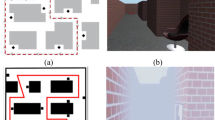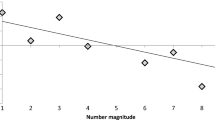Abstract
A previous study reported superior categorical and coordinate spatial task performance in inconsistent-versus consistent-right-handers (ICH versus CRH). Propper et al. used a three-dimensional (3D) computer-based task wherein individuals navigated to 21 locations within a realistic cityscape. During testing, participants were queried on their categorical and coordinate spatial knowledge of the map. In that study, the categorical and coordinate tasks may have inadvertently encouraged language coding of learned spatial information, potentially confounding spatial processing with recall ability for language-based information. Also, that study used a between-subjects design, which precludes examination of relationships between spatial knowledge as a function of handedness. The present study duplicated the learning task in Propper et al. using test stimuli that more faithfully represent spatial, and not language-based, information, as well as a within-subjects design. Results did not significantly replicate the previous study. Possible reasons for this finding are discussed.

Similar content being viewed by others
Explore related subjects
Discover the latest articles, news and stories from top researchers in related subjects.References
Baumann O, Chan E, Mattingley JB (2012) Distinct neural networks underlie encoding of categorical versus coordinate relations during active navigation. Neuroimage 60:1630–1637. https://doi.org/10.1016/j.neuroimage.2012.01.089
Brockmyer JH, Fox CM, Curtiss KA, McBroom E, Burkhart KM, Pidruzny JN (2009) The development of the game engagement questionnaire: a measure of engagement in video game-playing. J Exp Soc Psychol 45:624–634. https://doi.org/10.1016/j.jesp.2009.02.016
Brunye TT, Gardony A, Mahoney CR, Taylor HA (2012) Going to town: visualized perspectives and navigation through virtual environments. Comput Hum Behav 28:257–266. https://doi.org/10.1016/j.chb.2011.09.008
Burnett SA, Lane DM, Dratt LM (1982) Spatial ability and handedness. Intelligence 6:57–68. https://doi.org/10.1016/0160-2896(82)90020-4
Christman SD, Prichard EC, Corser R (2015) Factor analysis of the Edinburgh Handedness Inventory: inconsistent handedness yields a two-factor solution. Brain Cogn 98:82–86. https://doi.org/10.1016/j.bandc.2015.06.005
Edlin JM, Leppanen ML, Fain RJ, Hackländer RP, Hanaver-Torrez SD, Lyle KB (2015) On the use (and misuse?) of the Edinburgh Handedness Inventory. Brain Cogn 94:44–51. https://doi.org/10.1016/j.bandc.2015.01.003
Gardony AL, Taylor HA, Brunyé TT (2016) Gardony Map Drawing Analyzer: software for quantitative analysis of sketch maps. Behav Res Methods 48(1):151–177
Hegarty M, Richardson AE, Montello DR, Lovelace K, Subbiah I (2002) Development of a self-report measure of environmental spatial ability. Intelligence 30:425–448. https://doi.org/10.1016/S0160-2896(02)00116-2
Hellige JB (2001) Hemispheric asymmetry: what’s right and what’s left, vol 6. Harvard University Press, Cambridge
Laeng B, Chabris CF, Kossyln SM (2003) Asymmetries in encoding spatial relations. In: Hugdahl K, Davidson RJ (eds) The asymmetrical brain. The MIT Press, Cambridge, MA, pp 303–339
Niebauer CL (2001) A possible connection between categorical and coordinate spatial relation representations. Brain Cogn 47:434–445
Oldfield RC (1971) The assessment and analysis of handedness: the Edinburgh inventory. Neuropsychologia 9:97–113. https://doi.org/10.1016/0028-3932(71)90067-4
Pashler HP, Wagenmakers E-J (2012) Editors’ introduction to the special section on replicability in psychological science: a crisis of confidence? Perspect Psychol Sci 6:528–530
Prichard E, Propper RE, Christman, SD (2013) Degree of handedness, but not direction, is a systematic predictor of cognitive performance. Front Cogn 4, Article 9. https://doi.org/10.3389/fpsyg.2013.00009
Propper RE, Wolfarth A, Carlei C, Brunye TT, Christman SD (2018) Superior categorical and coordinate spatial task performance in inconsistent-handers relative to consistent-right-handers. Laterality 24(3):274–288
Slotnick SD, Moo LR, Tesoro MA, Hart J (2001) Hemispheric asymmetry in categorical versus coordinate visuospatial processing revealed by temporary cortical deactivation. J Cogn Neurosci 13:1088–1096. https://doi.org/10.1162/089892901753294383
Tian L, Wang J, Yan C, He Y (2011) Hemisphere- and gender-related differences in small-world brain networks: a resting-state functional MRI study. Neuroimage 54:191–202. https://doi.org/10.1016/j.neuroimage.2010.07.066
Funding
This study was not funded.
Author information
Authors and Affiliations
Corresponding author
Ethics declarations
Conflict of interest
All authors declare that there are no conflicts of interests.
Ethical approval
This article does not contain any studies with animals performed by any of the authors.
Human and animal rights
All procedures performed in studies involving human participants were in accordance with the ethical standards of the institutional and/or national research committee and with the 1964 Helsinki Declaration and its later amendments or comparable ethical standards.
Informed consent
Informed consent was obtained from all individual participants included in the study.
Additional information
Publisher's Note
Springer Nature remains neutral with regard to jurisdictional claims in published maps and institutional affiliations.
Handling editor: Benjamin Straube (University of Marburg).
Reviewers: Andrew Parker (Manchester Metropolitan University), Stephen Christman (University of Toledo).
Rights and permissions
About this article
Cite this article
Propper, R.E., Wolfarth, A., Brunye, T.T. et al. Categorical and coordinate spatial task performance in inconsistent-handers versus consistent-right-handers: part II. Cogn Process 20, 441–446 (2019). https://doi.org/10.1007/s10339-019-00926-x
Received:
Accepted:
Published:
Issue Date:
DOI: https://doi.org/10.1007/s10339-019-00926-x




